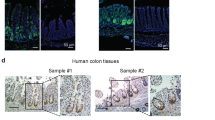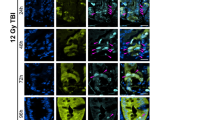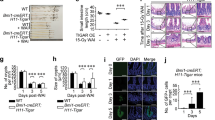Abstract
Gastrointestinal toxicity is the primary limiting factor in abdominal and pelvic radiotherapy, but has no effective treatment currently. We recently showed a critical role of the BH3-only protein p53 upregulated modulator of apoptosis (PUMA) in acute radiation-induced GI damage and GI syndrome in mice. Growth factors such as insulin-like growth factor 1 (IGF-1) and basic fibroblast growth factor (bFGF) have been shown to protect against radiation-induced intestinal injury, although the underlying mechanisms remain to be identified. We report here the suppression of PUMA through the phosphoinositide 3-kinase (PI3K)/protein kinase B (AKT)/p53 axis in the intestinal stem cells as a novel molecular mechanism of growth factor-mediated intestinal radioprotection. IGF-1 or bFGF impaired radiation-induced apoptosis and the expression of PUMA and p53 in the crypt cells and intestinal stem cells. Using colonic epithelial cells that undergo PUMA-dependent and radiation-induced apoptosis, we found that a PI3K inhibitor, dominant-negative PI3K or Mdm2 antagonist restored the induction of PUMA, p53 and apoptosis in the presence of growth factors. In contrast, overexpression of AKT suppressed the induction of PUMA and p53 by radiation. Furthermore, inhibiting PI3K or activating p53 abrogated growth factor-mediated suppression of apoptosis and PUMA expression in the intestinal crypts and stem cells after radiation.
This is a preview of subscription content, access via your institution
Access options
Subscribe to this journal
Receive 50 print issues and online access
$259.00 per year
only $5.18 per issue
Buy this article
- Purchase on Springer Link
- Instant access to full article PDF
Prices may be subject to local taxes which are calculated during checkout






Similar content being viewed by others
Abbreviations
- AKT:
-
protein kinase B
- bFGF:
-
basic fibroblast growth factor
- IGF-1:
-
insulin-like growth factor 1
- ISCs:
-
intestinal stem cells
- JNK:
-
c-Jun N-terminal kinase
- KO:
-
knockout
- MAPK:
-
mitogen-activated protein kinase
- PBS:
-
phosphate-buffered saline
- PI3K:
-
phosphoinositide 3-kinase
- PUMA:
-
p53 upregulated modulator of apoptosis
- TUNEL:
-
terminal deoxynucleotidyl transferase-mediated deoxyuridinetriphosphate nick end labeling
- WT:
-
wildtype
References
Adams JM, Cory S . (2007). The Bcl-2 apoptotic switch in cancer development and therapy. Oncogene 26: 1324–1337.
Barker N, van Es JH, Kuipers J, Kujala P, van den Born M, Cozijnsen M et al. (2007). Identification of stem cells in small intestine and colon by marker gene Lgr5. Nature 449: 1003–1007.
Booth D, Potten CS . (2001). Protection against mucosal injury by growth factors and cytokines. J Natl Cancer Inst Monogr 29: 16–20.
Bouleau S, Parvu-Ferecatu I, Rodriguez-Enfedaque A, Rincheval V, Grimal H, Mignotte B et al. (2007). Fibroblast growth factor 1 inhibits p53-dependent apoptosis in PC12 cells. Apoptosis 12: 1377–1387.
Bunz F, Dutriaux A, Lengauer C, Waldman T, Zhou S, Brown JP et al. (1998). Requirement for p53 and p21 to sustain G2 arrest after DNA damage. Science 282: 1497–1501.
Butt AJ, Firth SM, Baxter RC . (1999). The IGF axis and programmed cell death. Immunol Cell Biol 77: 256–262.
Ch'ang HJ, Maj JG, Paris F, Xing HR, Zhang J, Truman JP et al. (2005). ATM regulates target switching to escalating doses of radiation in the intestines. Nat Med 11: 484–490.
Clarke AR, Jones N, Pryde F, Adachi Y, Sansom OJ . (2007). 53BP1 deficiency in intestinal enterocytes does not alter the immediate response to ionizing radiation, but leads to increased nuclear area consistent with polyploidy. Oncogene 26: 6349–6355.
Fuchs SY, Adler V, Pincus MR, Ronai Z . (1998). MEKK1/JNK signaling stabilizes and activates p53. Proc Natl Acad Sci USA 95: 10541–10546.
George RJ, Sturmoski MA, May R, Sureban SM, Dieckgraefe BK, Anant S et al. (2009). Loss of p21Waf1/Cip1/Sdi1 enhances intestinal stem cell survival following radiation injury. Am J Physiol Gastrointest Liver Physiol 296: G245–G254.
Gottlieb TM, Leal JF, Seger R, Taya Y, Oren M . (2002). Cross-talk between Akt, p53 and Mdm2: possible implications for the regulation of apoptosis. Oncogene 21: 1299–1303.
Gu Q, Wang D, Wang X, Peng R, Liu J, Jiang T et al. (2004). Basic fibroblast growth factor inhibits radiation-induced apoptosis of HUVECs. I. The PI3K/AKT pathway and induction of phosphorylation of BAD. Radiat Res 161: 692–702.
Gulati AS, Ochsner SA, Henning SJ . (2008). Molecular properties of side population-sorted cells from mouse small intestine. Am J Physiol Gastrointest Liver Physiol 294: G286–G294.
Han J, Flemington C, Houghton AB, Gu Z, Zambetti GP, Lutz RJ et al. (2001). Expression of bbc3, a pro-apoptotic BH3-only gene, is regulated by diverse cell death and survival signals. Proc Natl Acad Sci USA 98: 11318–11323.
Houchen CW, George RJ, Sturmoski MA, Cohn SM . (1999). FGF-2 enhances intestinal stem cell survival and its expression is induced after radiation injury. Am J Physiol 276: G249–G258.
Ishizuka S, Martin K, Booth C, Potten CS, de Murcia G, Burkle A et al. (2003). Poly(ADP-ribose) polymerase-1 is a survival factor for radiation-exposed intestinal epithelial stem cells in vivo. Nucleic Acids Res 31: 6198–6205.
Jeffers JR, Parganas E, Lee Y, Yang C, Wang J, Brennan J et al. (2003). Puma is an essential mediator of p53-dependent and -independent apoptotic pathways. Cancer Cell 4: 321–328.
Katoh M . (2006). FGF signaling network in the gastrointestinal tract (review). Int J Oncol 29: 163–168.
Kohli M, Yu J, Seaman C, Bardelli A, Kinzler KW, Vogelstein B et al. (2004). SMAC/Diablo-dependent apoptosis induced by nonsteroidal antiinflammatory drugs (NSAIDs) in colon cancer cells. Proc Natl Acad Sci USA 101: 16897–16902.
Komarova EA, Kondratov RV, Wang K, Christov K, Golovkina TV, Goldblum JR et al. (2004). Dual effect of p53 on radiation sensitivity in vivo: p53 promotes hematopoietic injury, but protects from gastro-intestinal syndrome in mice. Oncogene 23: 3265–3271.
Korsmeyer SJ . (1999). BCL-2 gene family and the regulation of programmed cell death. Cancer Res 59: 1693s–11700s.
Labi V, Erlacher M, Kiessling S, Villunger A . (2006). BH3-only proteins in cell death initiation, malignant disease and anticancer therapy. Cell Death Differ 13: 1325–1338.
Levine AJ, Feng Z, Mak TW, You H, Jin S . (2006). Coordination and communication between the p53 and IGF-1-AKT-TOR signal transduction pathways. Genes Dev 20: 267–275.
Merritt AJ, Potten CS, Kemp CJ, Hickman JA, Balmain A, Lane DP et al. (1994). The role of p53 in spontaneous and radiation-induced apoptosis in the gastrointestinal tract of normal and p53-deficient mice. Cancer Res 54: 614–617.
Ming L, Sakaida T, Yue W, Jha A, Zhang L, Yu J . (2008). Sp1 and p73 activate PUMA following serum starvation. Carcinogenesis 29: 1878–1884.
Nakano K, Vousden KH . (2001). PUMA, a novel proapoptotic gene, is induced by p53. Mol Cell 7: 683–694.
Paris F, Fuks Z, Kang A, Capodieci P, Juan G, Ehleiter D et al. (2001). Endothelial apoptosis as the primary lesion initiating intestinal radiation damage in mice. Science 293: 293–297.
Potten CS . (2004). Radiation, the ideal cytotoxic agent for studying the cell biology of tissues such as the small intestine. Radiat Res 161: 123–136.
Qiu W, Carson-Walter EB, Liu H, Epperly M, Greenberger JS, Zambetti GP et al. (2008). PUMA regulates intestinal progenitor cell radiosensitivity and gastrointestinal syndrome. Cell Stem Cell 2: 576–583.
Sanchez-Prieto R, Rojas JM, Taya Y, Gutkind JS . (2000). A role for the p38 mitogen-acitvated protein kinase pathway in the transcriptional activation of p53 on genotoxic stress by chemotherapeutic agents. Cancer Res 60: 2464–2472.
Sangiorgi E, Capecchi MR . (2008). Bmi1 is expressed in vivo in intestinal stem cells. Nat Genet 40: 915–920.
Shangary S, Wang S . (2009). Small-molecule inhibitors of the MDM2-p53 protein-protein interaction to reactivate p53 function: a novel approach for cancer therapy. Annu Rev Pharmacol Toxicol 49: 223–241.
Shaulian E, Resnitzky D, Shifman O, Blandino G, Amsterdam A, Yayon A et al. (1997). Induction of Mdm2 and enhancement of cell survival by bFGF. Oncogene 15: 2717–2725.
Sun Q, Ming L, Thomas SM, Wang Y, Chen ZG, Ferris RL et al. (2009). PUMA mediates EGFR tyrosine kinase inhibitor-induced apoptosis in head and neck cancer cells. Oncogene 18: 2348–2357.
Villunger A, Michalak EM, Coultas L, Mullauer F, Bock G, Ausserlechner MJ et al. (2003). p53- and drug-induced apoptotic responses mediated by BH3-only proteins Puma and Noxa. Science 302: 1036–1038.
Vousden KH, Lu X . (2002). Live or let die: the cell's response to p53. Nat Rev Cancer 2: 594–604.
Waldman T, Kinzler KW, Vogelstein B . (1995). p21 is necessary for the p53-mediated G(1) arrest in human cancer cells. Cancer Res 55: 5187–5190.
Wang P, Yu J, Zhang L . (2007). The nuclear function of p53 is required for PUMA-mediated apoptosis induced by DNA damage. Proc Natl Acad Sci USA 104: 4054–4059.
Wilkins HR, Ohneda K, Keku TO, D'Ercole AJ, Fuller CR, Williams KL et al. (2002). Reduction of spontaneous and irradiation-induced apoptosis in small intestine of IGF-I transgenic mice. Am J Physiol Gastrointest Liver Physiol 283: G457–G464.
Wu B, Qiu W, Wang P, Yu H, Cheng T, Zambetti GP et al. (2007). p53 independent induction of PUMA mediates intestinal apoptosis in response to ischaemia-reperfusion. Gut 56: 645–654.
Yang JY, Xia W, Hu MC . (2006). Ionizing radiation activates expression of FOXO3a, Fas ligand, and Bim, and induces cell apoptosis. Int J Oncol 29: 643–648.
Yonish-Rouach E, Resnitzky D, Lotem J, Sachs L, Kimchi A, Oren M . (1991). Wild-type p53 induces apoptosis of myeloid leukaemic cells that is inhibited by interleukin-6. Nature 352: 345–347.
You H, Pellegrini M, Tsuchihara K, Yamamoto K, Hacker G, Erlacher M et al. (2006). FOXO3a-dependent regulation of Puma in response to cytokine/growth factor withdrawal. J Exp Med 203: 1657–1663.
Yu J, Wang P, Ming L, Wood MA, Zhang L . (2007). SMAC/Diablo mediates the proapoptotic function of PUMA by regulating PUMA-induced mitochondrial events. Oncogene 26: 4189–4198.
Yu J, Wang Z, Kinzler KW, Vogelstein B, Zhang L . (2003). PUMA mediates the apoptotic response to p53 in colorectal cancer cells. Proc Natl Acad Sci USA 100: 1931–1936.
Yu J, Zhang L . (2004). Apoptosis in human cancer cells. Curr Opin Oncol 16: 19–24.
Yu J, Zhang L . (2005). The transcriptional targets of p53 in apoptosis control. Biochem Biophys Res Commun 331: 851–858.
Yu J, Zhang L . (2008). PUMA, a potent killer with or without p53. Oncogene 27 (Suppl 1): S71–S83.
Yu J, Zhang L, Hwang PM, Kinzler KW, Vogelstein B . (2001). PUMA induces the rapid apoptosis of colorectal cancer cells. Mol Cell 7: 673–682.
Yu J, Zhang L, Hwang PM, Rago C, Kinzler KW, Vogelstein B . (1999). Identification and classification of p53-regulated genes. Proc Natl Acad Sci USA 96: 14517–14522.
Zhu L, Gibson P, Currle DS, Tong Y, Richardson RJ, Bayazitov IT et al. (2009). Prominin 1 marks intestinal stem cells that are susceptible to neoplastic transformation. Nature 457: 603–607.
Acknowledgements
We thank other members of our labs for helpful discussion and advice and Ms Hong Tao Liu for breeding mice. This work is supported in part by NIH grants CA106348, CA121105, and American Cancer Society grant RSG-07-156-01-CNE (L Zhang), and NIH grants CA129829, UO1-DK085570, U19-A1068021 (pilot project), and those from ACGT and FAMRI (J Yu).
Author information
Authors and Affiliations
Corresponding author
Additional information
Supplementary Information accompanies the paper on the Oncogene website (http://www.nature.com/onc)
Supplementary information
Rights and permissions
About this article
Cite this article
Qiu, W., Leibowitz, B., Zhang, L. et al. Growth factors protect intestinal stem cells from radiation-induced apoptosis by suppressing PUMA through the PI3K/AKT/p53 axis. Oncogene 29, 1622–1632 (2010). https://doi.org/10.1038/onc.2009.451
Received:
Revised:
Accepted:
Published:
Issue Date:
DOI: https://doi.org/10.1038/onc.2009.451
Keywords
This article is cited by
-
Downregulation of PUMA underlies resistance to FGFR1 inhibitors in the stem cell leukemia/lymphoma syndrome
Cell Death & Disease (2020)
-
EDNRB Reverses Methylprednisolone-Mediated Decrease in Neural Progenitor Cell Viability via Regulating PI3K/Akt Pathway and lncRNA Expression
Journal of Molecular Neuroscience (2020)
-
Discordant gene responses to radiation in humans and mice and the role of hematopoietically humanized mice in the search for radiation biomarkers
Scientific Reports (2019)
-
Dietary delphinidin inhibits human colorectal cancer metastasis associating with upregulation of miR-204-3p and suppression of the integrin/FAK axis
Scientific Reports (2019)
-
Synergistic actions of FGF2 and bone marrow transplantation mitigate radiation-induced intestinal injury
Cell Death & Disease (2018)



